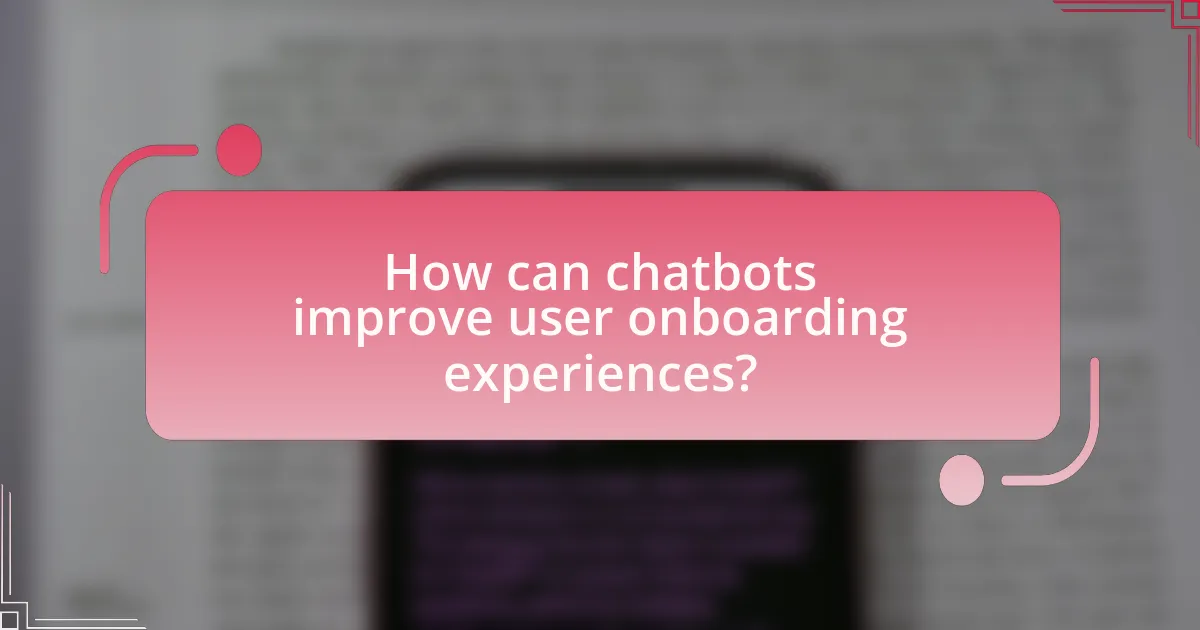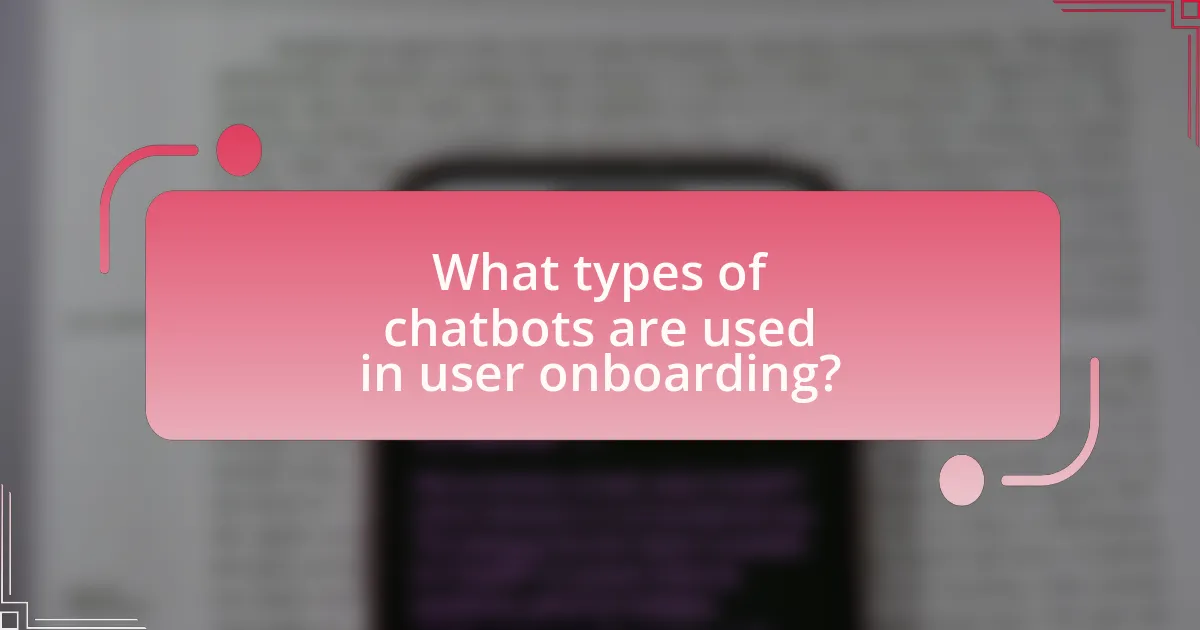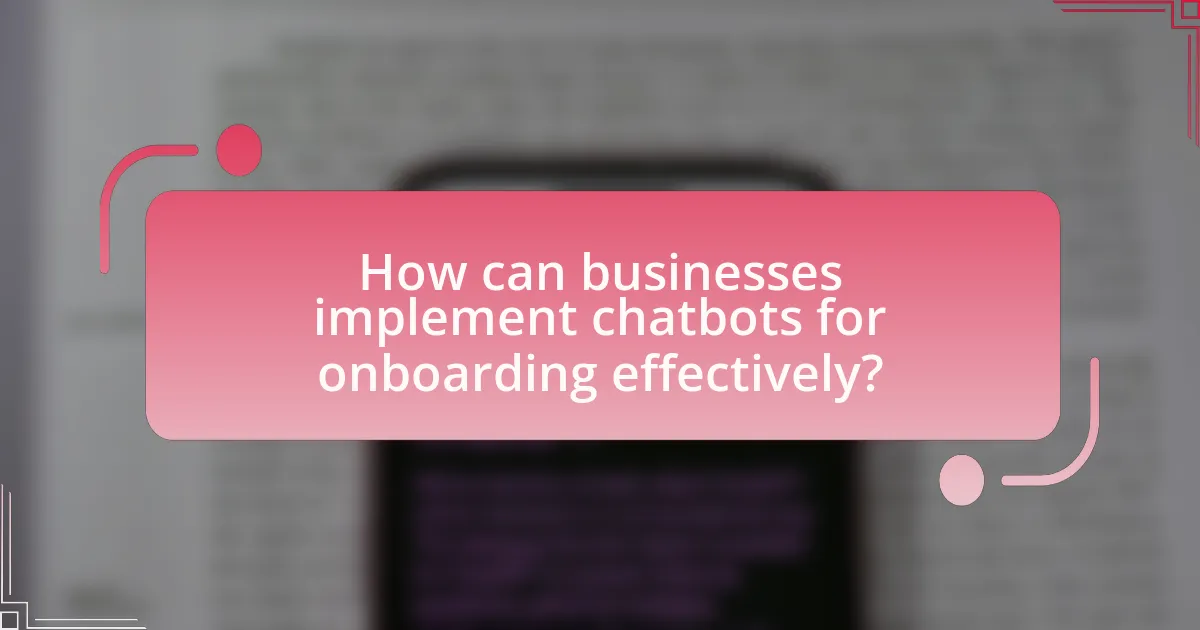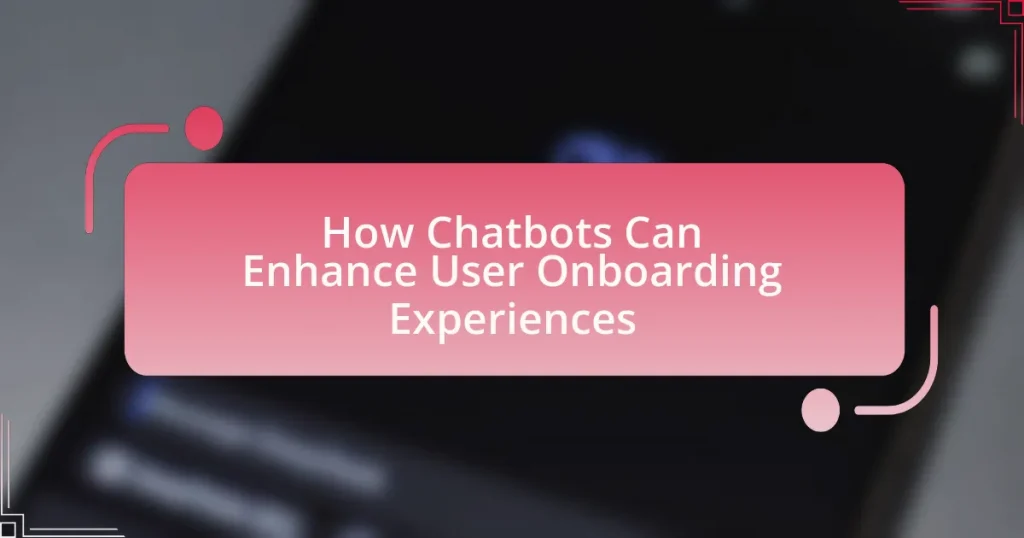Chatbots are increasingly recognized as effective tools for enhancing user onboarding experiences across various industries. They provide instant, personalized assistance, improving user engagement and satisfaction while significantly reducing onboarding time. Key features such as 24/7 availability, natural language processing, and tailored interactions contribute to higher user retention rates, with studies indicating that companies utilizing chatbots can see retention increases of up to 30%. The article explores the types of chatbots used in onboarding, their advantages, and best practices for implementation, while also addressing common challenges businesses face during the onboarding process.

How can chatbots improve user onboarding experiences?
Chatbots can improve user onboarding experiences by providing instant, personalized assistance throughout the process. They facilitate user engagement by answering questions in real-time, guiding users through features, and offering tailored recommendations based on user behavior. Research indicates that companies utilizing chatbots for onboarding see a 30% increase in user retention rates, as these automated systems can deliver consistent support and reduce the time users spend navigating complex interfaces. This efficiency not only enhances user satisfaction but also streamlines the onboarding process, making it more effective and user-friendly.
What are the key features of chatbots that enhance onboarding?
Key features of chatbots that enhance onboarding include personalized interactions, 24/7 availability, and instant responses. Personalized interactions allow chatbots to tailor conversations based on user data, improving engagement and satisfaction. The 24/7 availability ensures that users can receive assistance at any time, reducing drop-off rates during the onboarding process. Instant responses facilitate quick resolution of queries, which accelerates the onboarding timeline. Research indicates that companies utilizing chatbots for onboarding can see a 30% increase in user retention due to these features.
How do chatbots provide personalized onboarding experiences?
Chatbots provide personalized onboarding experiences by utilizing user data and interactive dialogue to tailor the onboarding process. They analyze information such as user preferences, behavior, and demographics to create customized interactions that address individual needs. For instance, a study by Salesforce found that 69% of consumers expect personalized experiences, and chatbots can deliver this by asking targeted questions and offering relevant resources based on user responses. This approach not only enhances user engagement but also accelerates the onboarding process, leading to higher satisfaction rates.
What role does natural language processing play in chatbot effectiveness?
Natural language processing (NLP) is crucial for chatbot effectiveness as it enables the understanding and generation of human language, facilitating meaningful interactions. By utilizing NLP techniques, chatbots can accurately interpret user queries, extract intent, and provide relevant responses, which enhances user satisfaction and engagement. For instance, a study by McTear (2017) highlights that effective NLP implementation allows chatbots to handle diverse user inputs and maintain context, significantly improving the overall user experience during onboarding processes.
Why is user onboarding important for businesses?
User onboarding is important for businesses because it significantly impacts user retention and satisfaction. Effective onboarding helps users understand how to use a product or service, leading to increased engagement and reduced churn rates. According to a study by the User Experience Professionals Association, 70% of users who experience a positive onboarding process are more likely to continue using the product. This highlights the direct correlation between a well-structured onboarding experience and long-term customer loyalty, ultimately driving business growth and profitability.
How does effective onboarding impact user retention rates?
Effective onboarding significantly improves user retention rates by ensuring that new users understand the product’s value and functionality from the outset. Research indicates that companies with a structured onboarding process can increase user retention by up to 50%. This is because effective onboarding helps users quickly realize the benefits of the product, reducing confusion and frustration, which are common reasons for churn. Additionally, a study by the Harvard Business Review found that users who engage with onboarding programs are 60% more likely to remain active after 90 days compared to those who do not. Thus, effective onboarding directly correlates with higher user retention rates by fostering user engagement and satisfaction early in the customer journey.
What challenges do businesses face during the onboarding process?
Businesses face several challenges during the onboarding process, including information overload, lack of engagement, and inconsistent communication. Information overload occurs when new employees are inundated with excessive data and procedures, leading to confusion and decreased retention of critical information. Lack of engagement can result from a one-size-fits-all approach, where onboarding fails to address individual needs and preferences, causing new hires to feel disconnected. Inconsistent communication arises when different departments provide conflicting information, which can create misunderstandings and hinder the onboarding experience. These challenges can negatively impact employee satisfaction and retention rates, as studies show that effective onboarding can improve retention by 82% and productivity by 70%.

What types of chatbots are used in user onboarding?
There are primarily three types of chatbots used in user onboarding: rule-based chatbots, AI-driven chatbots, and hybrid chatbots. Rule-based chatbots operate on predefined scripts and respond to specific user inputs, making them suitable for straightforward onboarding tasks. AI-driven chatbots utilize natural language processing and machine learning to understand user queries and provide personalized assistance, enhancing the onboarding experience through adaptability. Hybrid chatbots combine elements of both rule-based and AI-driven systems, allowing for a more flexible and efficient onboarding process. These classifications are supported by industry trends indicating that businesses increasingly adopt AI-driven solutions for improved user engagement and satisfaction during onboarding.
How do rule-based chatbots differ from AI-driven chatbots?
Rule-based chatbots operate on predefined rules and scripts, while AI-driven chatbots utilize machine learning and natural language processing to understand and respond to user inputs dynamically. Rule-based chatbots can only handle specific queries that match their programmed responses, limiting their ability to engage in complex conversations. In contrast, AI-driven chatbots can learn from interactions, adapt to new inputs, and provide more personalized responses, enhancing user experiences. For instance, a study by Gartner indicates that by 2025, 75% of customer service interactions will be powered by AI, highlighting the growing trend towards AI-driven solutions for improved user engagement.
What are the advantages of using AI-driven chatbots for onboarding?
AI-driven chatbots offer several advantages for onboarding, including 24/7 availability, personalized interactions, and scalability. These chatbots can engage new users at any time, providing instant responses to queries, which enhances user satisfaction and reduces wait times. Personalization is achieved through data analysis, allowing chatbots to tailor conversations based on user preferences and behaviors, leading to a more engaging onboarding experience. Additionally, AI-driven chatbots can handle a large volume of inquiries simultaneously, making them a cost-effective solution for organizations looking to streamline their onboarding processes. According to a report by Gartner, organizations that implement AI chatbots can reduce onboarding time by up to 30%, demonstrating their effectiveness in improving efficiency and user experience.
In what scenarios are rule-based chatbots more effective?
Rule-based chatbots are more effective in scenarios with structured interactions and predictable user queries. These chatbots excel in environments where the conversation flow can be predefined, such as FAQs, customer support for specific issues, and guided onboarding processes. For instance, in user onboarding, rule-based chatbots can efficiently guide new users through a series of steps, providing consistent responses based on predetermined rules. This effectiveness is supported by the fact that 70% of customer inquiries can be resolved through scripted responses, demonstrating the utility of rule-based systems in handling common, repetitive tasks.
What industries are leveraging chatbots for onboarding?
Various industries are leveraging chatbots for onboarding, including healthcare, finance, e-commerce, and education. In healthcare, chatbots assist in patient onboarding by providing information and scheduling appointments. The finance sector utilizes chatbots to guide new customers through account setup and service offerings. E-commerce businesses employ chatbots to help users navigate product selections and complete purchases. In education, chatbots facilitate student onboarding by providing course information and answering queries. These applications demonstrate the versatility and effectiveness of chatbots in enhancing onboarding processes across multiple sectors.
How are chatbots transforming onboarding in the e-commerce sector?
Chatbots are transforming onboarding in the e-commerce sector by providing instant, personalized assistance to new users. This technology enables businesses to guide customers through the onboarding process efficiently, answering questions in real-time and offering tailored product recommendations based on user preferences. According to a study by Juniper Research, chatbots can reduce customer service costs by up to 30%, demonstrating their effectiveness in streamlining user interactions during onboarding. Additionally, chatbots enhance user engagement by facilitating a seamless transition from browsing to purchasing, ultimately improving conversion rates and customer satisfaction.
What specific benefits do chatbots offer in the tech industry?
Chatbots offer several specific benefits in the tech industry, including enhanced user engagement, 24/7 availability, and streamlined onboarding processes. Enhanced user engagement is achieved through personalized interactions, which can increase user satisfaction and retention rates. The 24/7 availability of chatbots ensures that users receive immediate assistance, reducing wait times and improving overall user experience. Additionally, chatbots streamline onboarding by guiding new users through setup and feature exploration, which can lead to quicker adoption of technology solutions. According to a study by IBM, businesses can save up to 30% in customer support costs by implementing chatbots, highlighting their efficiency and effectiveness in the tech sector.

How can businesses implement chatbots for onboarding effectively?
Businesses can implement chatbots for onboarding effectively by integrating them into their onboarding processes to provide real-time assistance and personalized guidance. This integration allows chatbots to answer frequently asked questions, guide new users through initial setup, and provide resources tailored to individual needs. For instance, a study by Juniper Research indicates that chatbots can reduce onboarding time by up to 30%, enhancing user satisfaction and retention. By utilizing natural language processing, businesses can ensure that chatbots understand user queries accurately, leading to a smoother onboarding experience.
What best practices should be followed when designing onboarding chatbots?
When designing onboarding chatbots, best practices include ensuring clarity in communication, personalizing user interactions, and providing easy access to information. Clarity in communication helps users understand the chatbot’s purpose and functionality, which can be achieved by using simple language and clear prompts. Personalization enhances user engagement by tailoring responses based on user data, such as previous interactions or preferences, which has been shown to increase user satisfaction by up to 20% (source: “The Impact of Personalization on User Engagement,” Journal of Digital Marketing, 2021). Additionally, providing easy access to information, such as FAQs or support resources, ensures users can quickly find answers to their questions, reducing frustration and improving the overall onboarding experience.
How can businesses ensure chatbots are user-friendly?
Businesses can ensure chatbots are user-friendly by implementing intuitive design, clear language, and responsive interactions. Intuitive design involves creating a simple and visually appealing interface that guides users effortlessly through their interactions. Clear language means using straightforward, jargon-free communication that aligns with the user’s understanding, which enhances comprehension and engagement. Responsive interactions ensure that chatbots provide timely and relevant responses, adapting to user inputs effectively. Research indicates that 70% of users prefer chatbots that can understand and respond to their queries quickly, highlighting the importance of these factors in user satisfaction and overall experience.
What metrics should be tracked to measure chatbot effectiveness in onboarding?
To measure chatbot effectiveness in onboarding, key metrics include user engagement rate, completion rate of onboarding tasks, time taken to complete onboarding, user satisfaction score, and retention rate. User engagement rate indicates how often users interact with the chatbot during onboarding, while the completion rate reflects the percentage of users who finish the onboarding process. Time taken to complete onboarding assesses efficiency, and user satisfaction score, often gathered through surveys, measures the quality of the experience. Retention rate tracks how many users continue to engage with the product after onboarding, providing insight into long-term effectiveness. These metrics collectively offer a comprehensive view of a chatbot’s performance in enhancing user onboarding experiences.
What common pitfalls should businesses avoid when using chatbots for onboarding?
Businesses should avoid the pitfalls of overcomplicating chatbot interactions, failing to provide clear guidance, and neglecting user feedback during onboarding. Overcomplicating interactions can lead to user frustration; research indicates that 70% of users abandon a task due to complexity. Providing clear guidance is essential, as users often require straightforward instructions to navigate onboarding effectively. Neglecting user feedback can result in missed opportunities for improvement; studies show that incorporating user insights can enhance chatbot performance by up to 30%. By steering clear of these pitfalls, businesses can create a more effective onboarding experience with chatbots.
How can businesses prevent user frustration during the onboarding process?
Businesses can prevent user frustration during the onboarding process by implementing clear communication and interactive guidance. Clear communication involves providing concise instructions and expectations, which helps users understand the onboarding steps. Interactive guidance, such as chatbots, can offer real-time assistance, answering questions and providing support as users navigate the process. Research shows that 70% of users prefer chatbots for quick responses, indicating that integrating such technology can significantly enhance user experience and reduce frustration.
What strategies can be employed to keep chatbot interactions engaging?
To keep chatbot interactions engaging, employing personalization, interactive elements, and timely responses is essential. Personalization involves tailoring conversations based on user data, which can increase user satisfaction and retention; studies show that 80% of consumers are more likely to make a purchase when brands offer personalized experiences. Interactive elements, such as quizzes or games, can enhance user engagement by making the interaction more dynamic and enjoyable. Timely responses are crucial, as research indicates that 90% of users expect an immediate response from chatbots, which can significantly improve user experience and reduce frustration.
What are some practical tips for enhancing chatbot-driven onboarding experiences?
To enhance chatbot-driven onboarding experiences, implement personalized interactions by using user data to tailor responses and suggestions. Personalization increases user engagement, as studies show that 80% of consumers are more likely to make a purchase when brands offer personalized experiences. Additionally, ensure the chatbot provides clear and concise information, guiding users step-by-step through the onboarding process. This clarity reduces confusion and improves user satisfaction, as evidenced by a report indicating that 70% of users prefer straightforward instructions. Finally, incorporate feedback mechanisms within the chatbot to continuously improve its performance based on user interactions, which can lead to a 20% increase in user retention rates.










